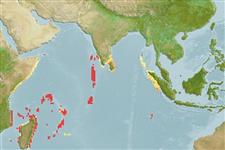Issue
The species has been synonymized with Cephalopholis urodeta (Forster, 1801) for a long time (e.g., Ref. 4787, Ref. 5222).
Environment: milieu / climate zone / depth range / distribution range
Ecología
marino asociado a arrecife; rango de profundidad 0 - 60 m (Ref. 89707), usually 0 - 15 m (Ref. 89707). Tropical; 12°N - 39°S, 40°E - 100°E (Ref. 89707)
Distribución
Países | Áreas FAO | Ecosistemas | Ocurrencias, apariciones | Point map | Introducciones | Faunafri
Indian Ocean: From East coast of Africa (Kenay to South Africa) to Sumatra; Comoros Is., Mascarene Is., Maldives, Sri Lanka, Chagos I.
Tamaño / Peso / Age
Maturity: Lm ? range ? - ? cm
Max length : 28.0 cm TL macho / no sexado; (Ref. 89707)
Short description
Morfología | Morfometría
Espinas dorsales (total): 9; Radios blandos dorsales (total): 14-16; Espinas anales 3; Radios blandos anales: 8 - 9. Characterized by red color grading to dark brown on posterior part of the body; posterior edge of operculum with prominent brown "ear" spot; body scales ctenoid, including abdomen; greatest depth of body 2.7-3.1 in SL; rounded caudal fin; pelvic fins 1.8-2.2 in head length (Ref. 90102); interorbital area convex; rounded preopercle, finely serrate, lower edge fleshy; subopercle and interopercle usually smooth; maxilla reaching well past eye (Ref. 089707).
Common throughout its range, the species inhabits coral-rich areas. It feeds on small fishes and crustaceans (Ref. 89707). Solitary (Ref 90102).
Life cycle and mating behavior
Madurez | Reproducción | Puesta | Huevos | Fecundidad | Larva
Craig, M.T., YJ. Sadovy de Mitcheson and P.C. Heemstra, 2011. Groupers of the world: a field and market guide. North America: CRC Press/Taylor and Francis Group. 356 p. (Ref. 89707)
IUCN Red List Status (Ref. 130435)
Threat to humans
Harmless
Human uses
Más información
PaísesÁreas FAOEcosistemasOcurrencias, aparicionesIntroduccionesStocksEcologíaDietacomponentes alimenticiosconsumo de alimentoRación
Nombres comunesSinónimosMetabolismoDespredadoresEcotoxicologíaReproducciónMadurezPuestaAgregación para la puestaFecundidadHuevosEgg development
Age/SizeCrecimientoLength-weightLength-lengthLength-frequenciesMorfometríaMorfologíaLarvaDinámica larvariaReclutamientoAbundanciaBRUVS
ReferenciasAcuiculturaPerfil de acuiculturaRazasGenéticaElectrophoresesheritabilidadEnfermedadesProcesamientoNutrientsMass conversion
ColaboradoresImágenesStamps, Coins Misc.SonidosCiguateraVelocidadTipo de nataciónSuperficie branquialOtolitosCerebrosVisión
Herramientas
Warning: mysqli::__construct(): (HY000/1040): Too many connections in /var/www/html/includes/speciessummary.lib.php on line 2414
Can't connect to MySQL database fbquizv2. Errorcode: Too many connections
